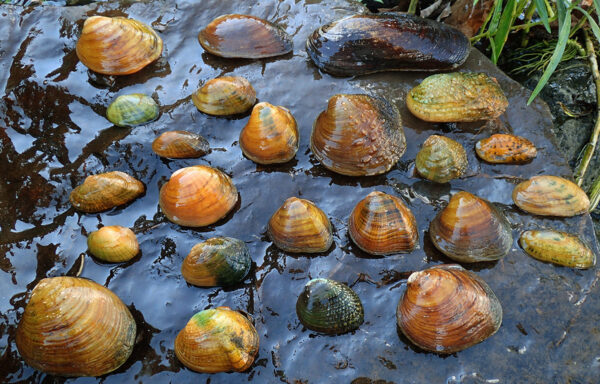
The Musselrama survey has started!
On Tuesday, September 5, 2017, in Scott County, Virginia, biologists from the Virginia Department of Wildlife Resources (DWR) and partnering agencies splashed into the scenic Clinch River to begin the week-long 2017 “MUSSELRAMA” surveys. The epic name given to this event (coined by our own nongame expert, Mike Pinder) evokes as much excitement among aquatic biologists and naturalists as the names “Lollapalooza” and “Bonnaroo” do for music lovers! Started in 2001, these intensive benthic surveys have been led annually in the Clinch and Powell rivers by DWR. The information collected is used to inform management actions aimed at protecting and enhancing this unique aquatic resource.

Snorkeling for mussels during musselrama
A chill in the air had forced most participants into full-length neoprene wetsuits but some braved the temperatures in swimsuits, all dawning masks and snorkels. Anticipation was building quickly for those who had already spent time snorkeling in one of America’s secret treasures, while newbies were excited from what seasoned pro’s had described to them leading up to the event. Nowhere else in the world do aquatic biologists have the chance to see so many rare and imperiled species in a single place as they do in this river nestled in the Appalachian Mountains of southwest Virginia.

The survey occurred in the Clinch river this year
The Clinch River, which flows through the far southwestern corner of the Commonwealth in Tazewell, Russell, and Scott counties before crossing into the state of Tennessee, boasts more endangered mussel species than any other river in North America. An amazing 55 species of mussels once inhabited the watershed. Unfortunately, pollution events, poor land use practices, loss of anadromous fish hosts and fragmented habitat caused by dams have reduced that number to 46 species, according to recent accounts. The Freshwater Mollusk Conservation Society considers 39 of the 46 species imperiled and the U.S. Fish & Wildlife Service have a mind-blowing 20 of these critters listed as Endangered throughout their ranges under the Endangered Species Act. Further, the river has over 100 freshwater fish species, 10 native crayfish species, 20 aquatic snails, and an imperiled giant salamander called a Hellbender. This makes the Clinch River a North American equivalent to the Great Barrier Reef or Amazon Rainforest and a hotspot for freshwater biodiversity nationwide.
For some imperiled species, this has become the only reliable place on the planet left to encounter and study them. Mussel densities at particular sites in the river have at times surpassed 50 mussels per square meter! This is incredible when you consider that individuals of many species have been proven capable of filtering 5–20 gallons of water per day. So, in these high-density locations, almost every drop of water used to be filtered as it flowed downstream to Norris Reservoir and benefited towns that rely on it as a municipal water source.
MUSSELRAMA ‘17 participants were not let down over the course of the work week. In total, 28 species were collected alive and examined, with fresh shells indicating at least 3 other species were probably present but not detected alive. Another seven species of relic, powdery shells were picked up (most known to be extirpated from Virginia), alluding to what should have been here prior to human impacts. To put this into perspective, there are 12 species of freshwater mussels on the entire continent of Europe, so more than twice that number were found alive in this one river over the course of four days!

Numerous mussel species were found
Mussel names were barked out across the river by snorkelers and recorded on data sheets as they made their way in lines upstream with the occasional excited shout as particularly rare species were encountered. Most people love to hear the common names bestowed upon these critters, like ‘Black Sandshell,’ ‘Purple Wartyback’, ‘Birdwing Pearlymussel’, ‘Cracking Pearlymussel,’ ‘Shiny pigtoe,’ ’Snuffbox,’ ‘Elephant Ear’ and ‘Pink Mucket.’ Some of the animals were measured for length to help inform researchers of the population’s age structure and health. Almost half of the species encountered over the week were documented to have some level of natural recruitment, giving reassurance that these particular shoals are healthy and appear to be functioning normally.

The growth and maturation of the collected mussels was surveyed
One of the sites was chosen because it is a DWR augmentation site and the focus of many restocking activities. In fact, staff from the Department’s Aquatic Wildlife Conservation Center in Marion, VA have reared and stocked 8 federally endangered species and 2 others to this site over the last ten years and this was one of the first chances biologists have been afforded to assess their condition and performance in the wild. The survey revealed 9 of the 10 stocked species were alive and well, with all exhibiting good growth and maturation.
Shell tags and passive transponder tags helped the stocked mussels to be differentiated from their wild neighbors. Many of the females were documented gravid with larvae brooded in preparation to broadcast to their fish hosts. Some of these species live as long as 70 or 80 years, so these efforts will hopefully provide a long-lasting effect on these areas of the river. Still, it will take an investment by the public to ensure that these efforts are not in vain. Without humans appreciating and protecting this resource, it will only continue to dwindle to the point of so many other rivers in the region.
Biologists left the week able to say they were there for another unforgettable MUSSELRAMA! New sites will be chosen for the event next year and DWR biologists and our partners will continue to push forward with efforts to maintain this special fauna for generations to come!
This article was written by Tim Lane, Southwest Virginia Mussel Recovery Coordinator, Virginia Department of Wildlife Resources


